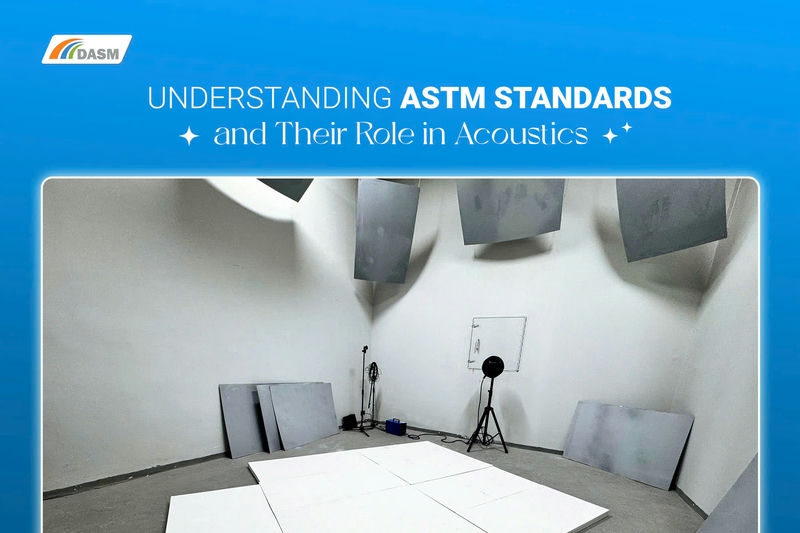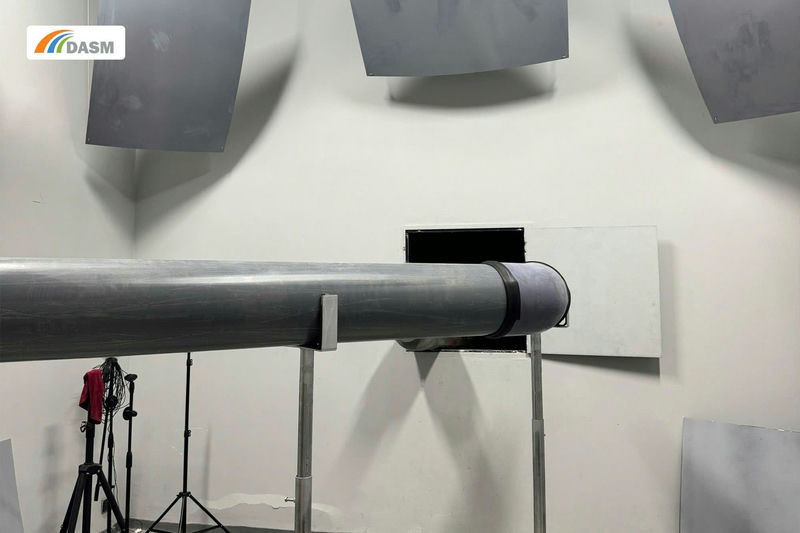ASTM International (formerly the American Society for Testing and Materials) is an international organization that develops and recognizes technical standards for materials, products, systems, and services. ASTM standards are applied in many fields, including construction materials, energy, electronics, healthcare, and especially acoustics.

ASTM standards and acoustics
In the field of acoustics, ASTM standards play an essential role in identifying and measuring the acoustic properties of materials, helping to optimize design and quality in construction, especially in areas such as sound absorption, soundproofing, and thermal insulation.
ASTM standards provide test methods to determine the sound absorption coefficients and sound insulation properties of materials or building structures. These help engineers and designers ensure that the materials used in a space meet noise and acoustic performance requirements.
Acoustic Absorption Testing Service at DASM Institute According to ISO 354 & ASTM C423
Soundproofing Test of Remak® XPS Foam in an Impedance Tube at DASM
Adapter Noise Measurement According to ISO 3745-2012 – Quality Inspection at DASM Institute
Common ASTM standards in acoustics
Below is a list of common ASTM standards in acoustics, including those related to the measurement and evaluation of soundproofing, sound absorption, and noise reduction:
1. ASTM C423 – Measurement of sound absorption coefficients (NRC)
This standard is used to determine the sound absorption performance of materials in a reverberation room, which helps assess the noise-reduction capabilities of materials.
2. ASTM E90 – Measurement of sound transmission loss through walls
This standard measures the noise reduction across walls or structures, evaluating soundproofing effectiveness between spaces.
3. ASTM E413 – Determination of sound transmission class (STC)
STC is an index used to assess the overall soundproofing ability of materials and structures in preventing sound transmission.
4. ASTM E336 – Field measurement of sound transmission between rooms in actual buildings
This standard measures sound transmission between rooms in real-world buildings, assessing the effectiveness of in-situ sound insulation.
5. ASTM E1050 – Measurement of acoustic absorption using impedance tubes
This method uses an impedance tube to evaluate the sound absorption of materials, aiding in the design of effective soundproof spaces.
6. ASTM E795 – Methods for measuring sound insulation in rooms and between spaces
This standard is used to assess sound insulation within and between rooms in a building, ensuring effective acoustic separation.
7. ASTM C1340 – Sound insulation testing of windows
This standard measures the soundproofing capacity of windows, helping to evaluate their ability to block external noise from entering indoor spaces.
8. ASTM C1428 – Evaluation of the sound insulation properties of building panels
Used to assess the soundproofing performance of building panels, especially in comprehensive sound insulation systems for buildings.
9. ASTM E1238 – Measurement of acoustic properties of double-wall partitions
This standard measures the sound insulation effectiveness of double walls, assessing their ability to reduce noise in buildings with dual-layer partitions.
10. ASTM E1332 – Determination of noise reduction and room sound levels
This standard evaluates the noise reduction capabilities of room structures and measures indoor noise levels to help create quieter, more comfortable spaces.

These standards support the design of recording studios, theaters, offices, residential buildings, and are foundational for green building projects seeking LEED, LOTUS, or WELL certifications.
The critical role of ASTM standards in acoustic design
• Provide accurate testing methods:
They help evaluate material performance and support the correct selection of materials for noise-reduction purposes.
• Ensure international compliance:
ASTM standards are globally recognized, helping products and projects meet international technical and quality requirements.
• Support space optimization:
These standards allow for the measurement, calculation, and adjustment of acoustic performance in buildings, improving living and working environments.
DASM – Acoustic testing lab accredited to ASTM standards and VILAS
DASM is an acoustic testing laboratory accredited to ASTM standards and recognized under the VILAS system. It operates under the ISO/IEC 17025 quality management system – the highest international certification for measurement and testing technical competency.
At DASM, all acoustic measurements and tests are conducted in strict compliance with ASTM standards using:
• Modern, regularly calibrated equipment that meets international standards
• Well-trained experts with years of experience
• Rigorous procedures ensuring objective results with legal value
All acoustic testsing at DASM are performed according to international standards.

Benefits of choosing DASM
• Meets technical requirements for project acceptance and inspection
• Accepted in bidding, design consulting, and acoustic supervision
• Supports green building projects seeking international certification
ASTM standards are crucial tools to ensure that acoustic requirements are implemented accurately and effectively. Applying these standards correctly helps achieve optimal acoustic performance in construction and design, ensuring ideal living and working environments.
Contact DASM today for expert consultation and detailed pricing on internationally standardized acoustic services for your products and projects.







